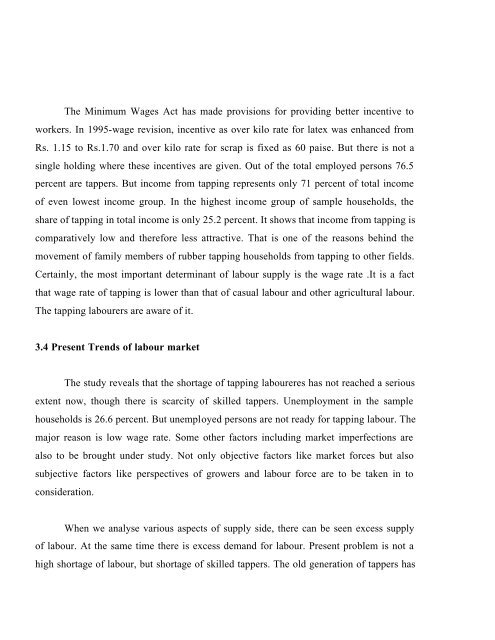socio-economic profile of rubber tappers in the small holding sector
socio-economic profile of rubber tappers in the small holding sector
socio-economic profile of rubber tappers in the small holding sector
Create successful ePaper yourself
Turn your PDF publications into a flip-book with our unique Google optimized e-Paper software.
The M<strong>in</strong>imum Wages Act has made provisions for provid<strong>in</strong>g better <strong>in</strong>centive to<br />
workers. In 1995-wage revision, <strong>in</strong>centive as over kilo rate for latex was enhanced from<br />
Rs. 1.15 to Rs.1.70 and over kilo rate for scrap is fixed as 60 paise. But <strong>the</strong>re is not a<br />
s<strong>in</strong>gle hold<strong>in</strong>g where <strong>the</strong>se <strong>in</strong>centives are given. Out <strong>of</strong> <strong>the</strong> total employed persons 76.5<br />
percent are <strong>tappers</strong>. But <strong>in</strong>come from tapp<strong>in</strong>g represents only 71 percent <strong>of</strong> total <strong>in</strong>come<br />
<strong>of</strong> even lowest <strong>in</strong>come group. In <strong>the</strong> highest <strong>in</strong>come group <strong>of</strong> sample households, <strong>the</strong><br />
share <strong>of</strong> tapp<strong>in</strong>g <strong>in</strong> total <strong>in</strong>come is only 25.2 percent. It shows that <strong>in</strong>come from tapp<strong>in</strong>g is<br />
comparatively low and <strong>the</strong>refore less attractive. That is one <strong>of</strong> <strong>the</strong> reasons beh<strong>in</strong>d <strong>the</strong><br />
movement <strong>of</strong> family members <strong>of</strong> <strong>rubber</strong> tapp<strong>in</strong>g households from tapp<strong>in</strong>g to o<strong>the</strong>r fields.<br />
Certa<strong>in</strong>ly, <strong>the</strong> most important determ<strong>in</strong>ant <strong>of</strong> labour supply is <strong>the</strong> wage rate .It is a fact<br />
that wage rate <strong>of</strong> tapp<strong>in</strong>g is lower than that <strong>of</strong> casual labour and o<strong>the</strong>r agricultural labour.<br />
The tapp<strong>in</strong>g labourers are aware <strong>of</strong> it.<br />
3.4 Present Trends <strong>of</strong> labour market<br />
The study reveals that <strong>the</strong> shortage <strong>of</strong> tapp<strong>in</strong>g laboureres has not reached a serious<br />
extent now, though <strong>the</strong>re is scarcity <strong>of</strong> skilled <strong>tappers</strong>. Unemployment <strong>in</strong> <strong>the</strong> sample<br />
households is 26.6 percent. But unemployed persons are not ready for tapp<strong>in</strong>g labour. The<br />
major reason is low wage rate. Some o<strong>the</strong>r factors <strong>in</strong>clud<strong>in</strong>g market imperfections are<br />
also to be brought under study. Not only objective factors like market forces but also<br />
subjective factors like perspectives <strong>of</strong> growers and labour force are to be taken <strong>in</strong> to<br />
consideration.<br />
When we analyse various aspects <strong>of</strong> supply side, <strong>the</strong>re can be seen excess supply<br />
<strong>of</strong> labour. At <strong>the</strong> same time <strong>the</strong>re is excess demand for labour. Present problem is not a<br />
high shortage <strong>of</strong> labour, but shortage <strong>of</strong> skilled <strong>tappers</strong>. The old generation <strong>of</strong> <strong>tappers</strong> has










